Novel Curved Serpentine Heat Exchanger Coils
Conventional coil designs, such as helical and flat serpentine (FS) coils, are commonly employed for heat transfer applications due to their higher heat transfer performance and compactness. In the last few decades, chaotic coil designs have attracted the attention of a few researchers due to their superior thermohydraulic performance. We present a novel and simple chaotic coil design termed the curved serpentine (CS-θ) coil, which is a modified version of the conventional FS coil. The straight tubes of length L in the FS coil are bent as arcs of radius R1 and subtended angle θ (i.e., L = R1 × θ), which are interconnected with U-bends of radius R2. The laminar flow of water through the CS-θ coil is numerically investigated, and the peaks and valleys in the local Nusselt number and friction factor at various axial locations are explained with the help of velocity and temperature contours and secondary flow patterns. The chaotic nature of flow through these coils is explained with the help of streamlines and transverse flow vectors, transversal intersection of the trajectories, and the Lyapunov spectrum. The thermohydraulic performance (η) of this coil is found superior to conventional FS and helical coils. It is found that the CS-θ coils, in which the flow is fully developed just before entering the U-bend, can achieve the best thermohydraulic performance. We also propose generalized correlations for predicting the average Nusselt number and friction factor in the CS-θ coils with a maximum deviation of ±10% and ±7.5%, respectively.
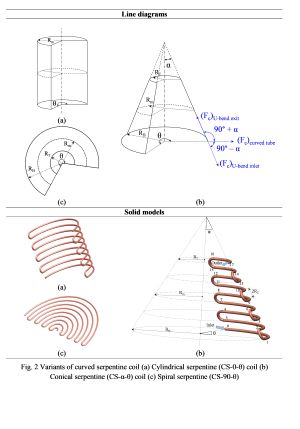 |
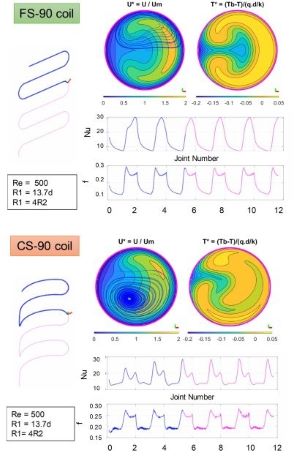 |
|
Two variants of the novel curved serpentine coil formed by relaxing the switching angle at the junctions are explored and compared with the original design for the same mean radius Rm of concentric tubes. With α as the semi-cone angle and θ as the subtended angle of concentric tubes, the general notation given to different variants of the curved serpentine coil is CS-α-θ. The three variants are named as a cylindrical curved serpentine coil (α = 0°), conical curved serpentine coil (0° < α < 90°), and spiral curved serpentine coil (α = 90°). The fluid experiences a switching angle of 90° − α and 90° + α at the entrance and exit of every U-bend, respectively. The laminar flow of water in CS-α-θ coils (45° ≤ θ ≤ 270°, 0° ≤ α ≤ 90°) is simulated using ANSYS FLUENT version 20.2 for the range 500 ≤ Re ≤ 2000. The length-averaged Nu and f are found to decrease with an increase in either α or θ for the same mean radius Rm of concentric tubes. Secondary flow intensity is quantified using the parameter Se and is correlated with the flow and geometric parameters. Generalized correlations for predicting the average Nusselt number and friction factor for CS-α-θ coils are expressed as the sum of corresponding straight tube values and as a function of Se with a maximum deviation of ±8.5% and ±7%, respectively.
Scheffler Reflector
Technologies used to harness solar energy have emerged as the most promising and mature since solar energy is abundant, freely available, and it has commercial potential too. The geographical location of India is quite suitable for harvesting the true potential of Solar energy. Different designs of Solar Collectors are being investigated in order to achieve the optimal performance.
Scheffler reflector, a special category of concentrated solar collector, has unique features such as non-moving focal area, flexible surface curvature and shadow-less concentration. It is essentially a lateral part of the paraboloid formed by its interception with an inclined plane. Its fabrication requires attaching mirrors/reflecting film to the supporting frame, which consists of an elliptical rim, a central parabolic support and a number of elliptical crossbars. The existing design approximates elliptical crossbars by circular crossbars. To simplify this, design charts have been developed and published by reputed Elsevier journal of Solar Energy.
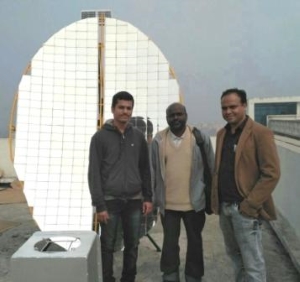 |
 |
|
Novel Fresnel lens with unequal facet radii
A Fresnel lens is obtained from a plano-convex lens, whose spherical surface is split into a number of divisions (called facets), collapsed onto the flat base. Thus, all the facets of the original Fresnel lens have the same radius as that of the plano-convex lens. The proposed design aims to achieve better ray concentration and reduced spherical aberration than the original Fresnel lens by constructing spherical facets with unequal radii. The centers and radii of facets are constrained so that the ray refracted from the bottom vertex of each facet on one side of the optical axis and the ray refracted from the outer vertex of the corresponding facet on the other side of the optical axis must intersect at the focal plane. The proposed lens design has resulted in a 275% gain in the concentration ratio and a 72.5% reduction in the spherical aberration compared to the original lens of the same aperture diameter and number of facets. The performance of both novel and original Fresnel lenses when used as solar concentrators with a conical coil receiver is evaluated. The novel Fresnel lens led to increased heat gain and resulted in a compact solar collector design.
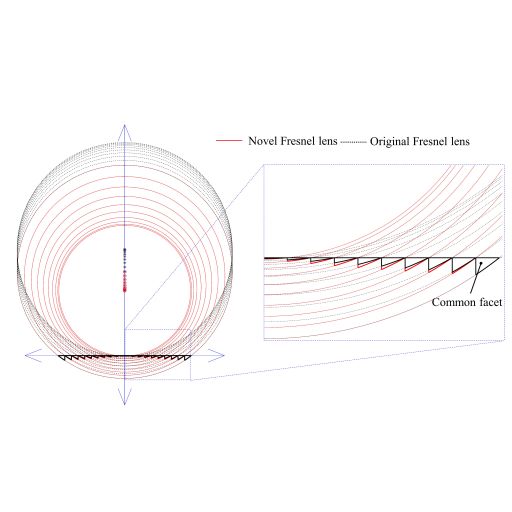 |
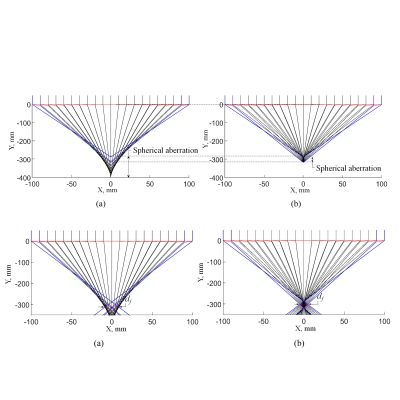 |
|
Nuclear Safety
Zircaloys, a class of zirconium alloys, are extensively used as a cladding material for nuclear fuel. Zircaloys are preferred to other materials' cladding because of their strikingly low thermal neutron cross-section, apt thermal conductivity, dimensional stability and corrosion resistance in the harsh environment of a reactor core. Diffusion of hydrogen in Zircaloy during its service time may severely impact its critical properties like dimensional stability, mechanical strength, its corrosion and creep behaviour etc. The severity of hydrogen ingress or hydride formation in Zircaloy fuel claddings can be assessed from the fact that it is responsible for the determination of service time of fuel claddings. In spite of noteworthy progress in technologies related to nuclear safety, the various phenomena correlated with hydrogen embrittlement remain ambiguous. Influence of Hydrides on the burst characteristics of Zircaloy-4 nuclear fuel clad tube is being investigated.
 |
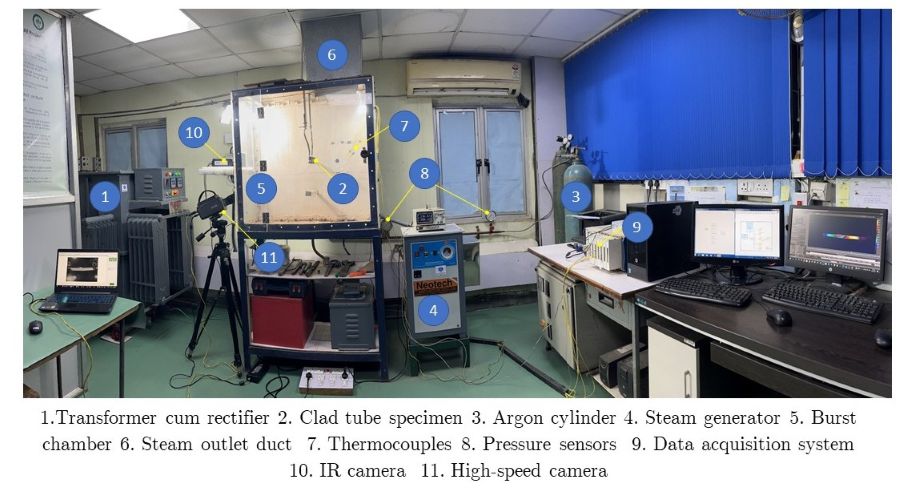 |
|
An extensive burst investigation has been carried out on the zircaloy-4 claddings in an inert environment to simulate clad burst during a postulated loss-of-coolant-accident (LOCA) conditions. The parameters varied during the burst experiments were heating rate and internal overpressure. The temperature, internal overpressure and ballooning data were monitored online and recorded during the heating process of burst specimen. In addition, post-experiment measurements were also conducted on the burst specimen to determine various burst parameters-burst strains and burst stress. A semi-empirical correlation was developed to predict the burst stress for a given burst temperature. A reasonable agreement between the predicted and experimental data has been observed. The proposed correlation was also compared with available established correlation for steam environment
Novel Hyperbolic Ribs

A 2-D CFD simulation for the turbulent flow inside solar air heater with artificially roughened absorber plate has been carried out using
ANSYS FLUENT software. For turbulent modeling RNG k-e model is used. The artificial roughness or rib geometry used in the present simulation has parabolic profile. Presence of ribs on absorber plate causes the laminar sub-layer
to break leading to the formation of eddies in the downstream steam direction. Eddies promote mixing of different fluid layers resulting in an enhanced heat transfer rate from absorber plate's surface. On the other hand,
the frictional pressure drop is also increased due to the presence of ribs on absorber plate surface. The model is validated with the Dittus-Boelter Nusselt number correlation and Blasius equation for heat transfer and
frictional pressure drop respectively for smooth duct. The results are found to be in very good agreement with the above well-established correlations. A parametric study of parabolic rib geometry has been presented.
Range of relative roughness e/Dh is 0.03 - 0.06, pitch to rib height ratio p/e is 10 - 20 and Reynolds number Re is 4000 - 15000.
Multi-Phase Flow
In order to meet the requirement of enhanced functionalities, high speed operation and miniaturizing physical size, power density in electronic devices has been tremendously increased in recent years. This has resulted in high heat generation in the devices and conventional cooling systems such as fins and fans are not sufficient for thermal management of such devices. Microchannel based cooling techniques have immense prospect in dissipating high heat flux from such devices, due to high heat transfer coefficient and compactness of the system. From the perspective of cooling performance, two-phase evaporative flow or flow boiling in microchannels is more effective than the single phase flow due to involvement of latent heat in the process. High heat removal using low coolant flow rate and temperature uniformity in the channels are two favourable characteristics of two-phase cooling technique. However, backflow and instability occur during flow boiling in micro-channels resulting non-uniform flow and poor heat transfer in the system. All these phenomena create fluctuations in temperature and pressure of the coolant flow. In order to overcome all these issues during Multi-phase flow in Micro-channels, various configurations like segemnted, diverging etc. are experiemnted.
 |
 |
|
Non-Newtonian Fluids
Convection in viscosplastic fluids has a great scientific relevance owing to its widespread applications ranging from food, chemical and cosmetic industries to natural phenomena like flow of lava and mud. Viscoplastic fluids are characterized by solid-like behavior under applied stress below a critical stress known as yield stress. They behave like fluids once applied stress exceeds yield stress. Investigations pertaining to convection in Newtonian fluids are quite common in the literature. However, the understanding of convection phenomenon in yield stress materials is not well established. Presently, thermal instability, onset of convection, evolving shape and size of yielded and unyielded zones, existence of sharp boundary between yielded and unyielded regions, movement of plugged region are some of the pertinent issues that are being investigated.
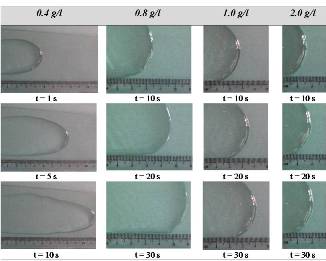 |
 |
|
